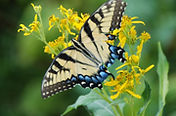sensitive fern (Onoclea sensibilis)
COMMON NAMES:
sensitive fern
bead fern
SCIENTIFIC SYNONYMS: There are no scientific synonyms for
Onoclea sensibilis.
TAXONOMY: The currently accepted scientific name for sensitive fern
is Onoclea sensibilis L.
NATIVE STATUS: Native, United States and Canada.
GENERAL BOTANICAL CHARACTERISTICS:This perennial fern
consists of a few loose leaves that develop directly from the rootstock. The infertile leaves (including their petioles) are 1½–3' tall and erect or ascend-
ing, while the fertile leaves (including their petioles) are ¾–1½' tall and
erect. Infertile leaves are more common than fertile leaves. The infertile
leaves are yellowish green to medium green, hairless, and ovate in outline;
they are deeply pinnatifid for the most part, although their tips are more
shallowly pinnatifid, while their bases are more pinnate. The central stalk
(or rachis) of each infertile leaf is winged. The spreading narrow lobes of
the infertile leaves are generously spaced from each other; their margins
are smooth to undulate and gently roll downward. Each infertile leaf has
about 8 opposite pairs of these lobes; the upper lobes are ascending, the
middle lobes are widely spreading, and the lower lobes are descending.
The petioles of infertile leaves are usually shorter than their blades; they
are light yellowish green to reddish brown and glabrous to slightly scaly.
The infertile leaves persist all summer, but die down during the autumn in response to frost.The fertile leaves have a very different appearance. Their
leaflets are contracted to form hardened structures that support the bead-
like sporangia and their spores. In outline, each fertile leaf is ellipsoid-ob-
longoid, forming a narrow panicle of erect contracted leaflets with sporan-
gia on a central stalk (or rachis). The fertile leaves become dark brown
and persist through the winter into the following year. Eventually, the spor-
angia split open to release their spores; these spores are distributed by the
wind. The root system consists of a stout smooth rhizome with spreading
fibrous roots. This rhizome occasionally branches. Small clonal colonies
of plants are often formed from the branching rhizomes.
REGENERATION PROCESS: Sensitive fern propogates itself by
spores and vegetative spread (i.e., rhizomes).
HABITAT TYPES: Habitats include wet to mesic deciduous woodlands,
lowland sandy savannas, wooded bluffs, soggy thickets, forested bogs,
swamps, moist meadows, moist sand prairies, edges of marshes, shaded
seeps, and low shaded areas along small streams and vernal pools. Sensi-
tive fern is usually found in natural areas of moderate to high quality.
SITE CHARACTERISTICS: Sensitive fern prefers partial sun to light
shade, wet to moist conditions, humid locations that are sheltered from
prevailing winds, and sandy or loamy soil containing decaying organic
matter.
SEASONAL DEVELOPMENT: Spores of sensitive fern are produced
August through September.
GENERAL DISTRIBUTION: Sensitive fern occurs throughout all of
eastern United States and Canada, extending west to Texas and then north
into Colorado, Wyoming and north to Manitoba.
SKY MEADOWS DISTRIBUTION: To be determined.
IMPORTANCE AND USES: Insects that feed on sensitive fern include
the aphid Amphorophora ampullata, larvae of the sawfly Hemitaxonus
dubitatus, and larvae of Papaipema inquaesita (sensitive fern borer moth).
The aphid sucks plant juices from this fern, the sawfly larvae feed on the
leaves, and the moth larvae bore into the stems and roots. White-tailed
deer will eat the infertile leaves.
Sensitive fern contains toxic compounds that have not yet been identified,
and little is known regarding conditions of toxicity. Poisonings have been
reported for horses consuming sensitive fern foliage.
Sensitive fern is cultivated as an ornamental plant, in traditional and native
plant gardens, and in natural landscaping and habitat restoration projects.
Park Activities
Calendar of Events
Volunteer Programs
Sky Meadows Park
Location
Geography
Habitats
Trails
Visiting Park
Crooked Run Valley
Special Projects


